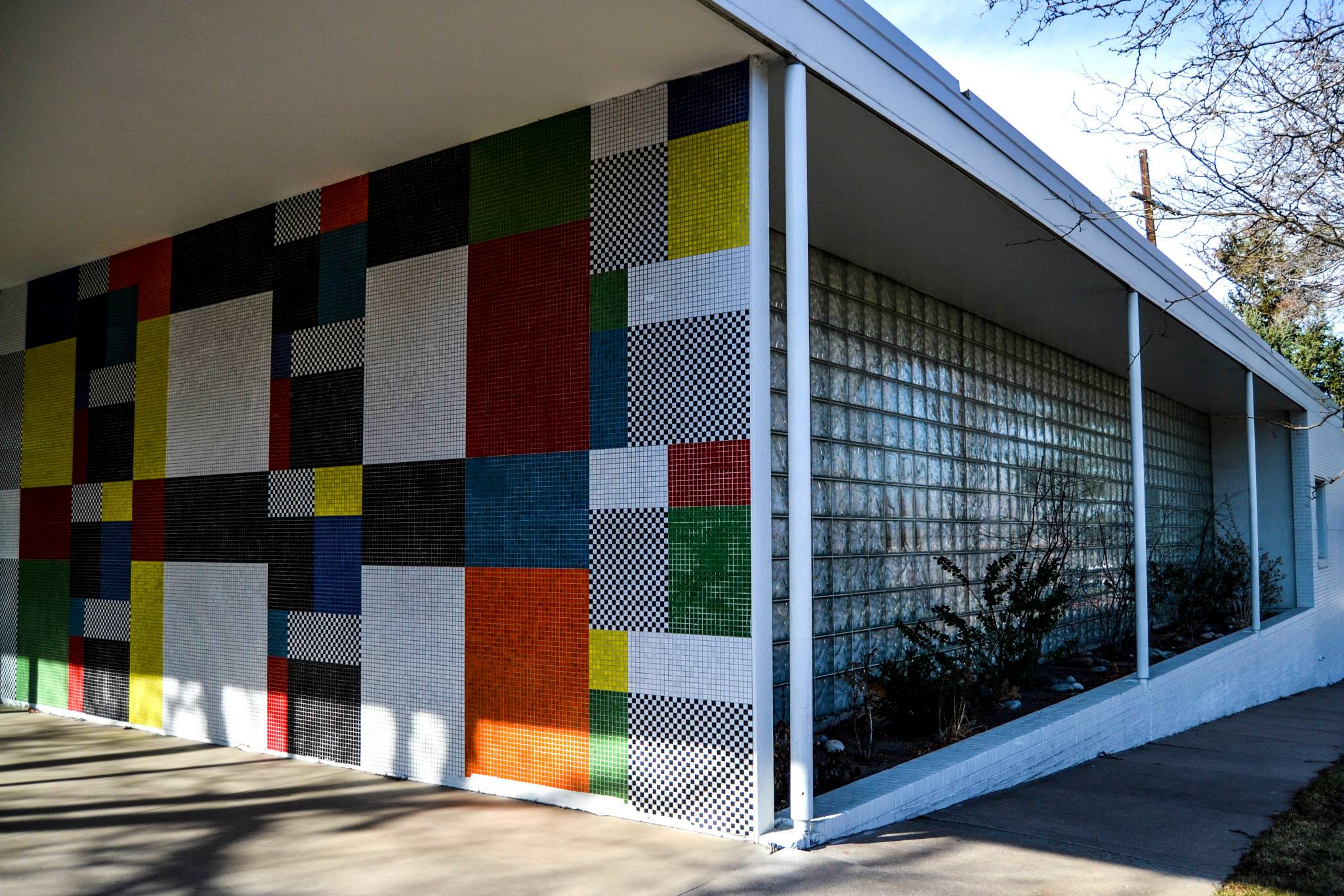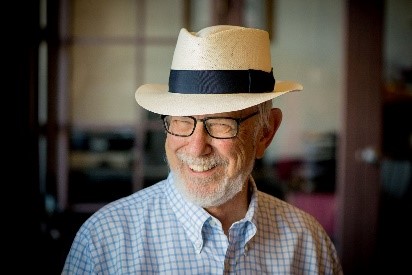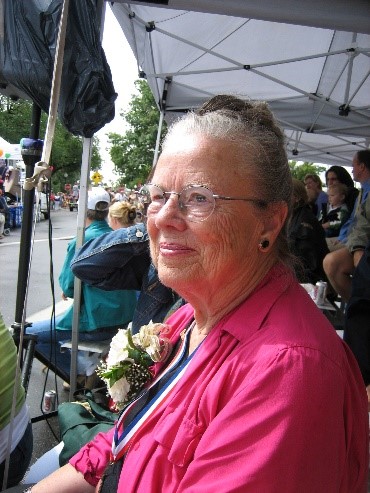Identifying and Protecting Our
Recent Cultural Heritage – Recognition
of Mid-Century Architecture
“Recognition of our cultural heritage is an evolution that can take decades,” said Rick Cronenberger regarding the identification and protection of Mid-Century Modern Commercial architecture—and all cultural resources—in Littleton. Fortunately, Littleton got off to a good start with Robert “Bob” McQuarie.
Documenting History
Bob McQuarie, Littleton’s first museum director and historian, initially recognized the importance of Littleton’s Mid-Century Modern Commercial architecture. In the first of two Historic Building Surveys of Littleton conducted in the late 1970s, he recognized the following as significant: the Title Guaranty Company and Littleton Savings and Loan buildings (both by architects Joseph and Louise Marlow) and Eugene Sternberg’s numerous brutalist buildings (such as Arapahoe Community College’s main building and Heritage High School).
Bob published the first history of the City, Littleton Colorado, Settlement to Centennial, in 1990. The book provides a great overview of the City’s history and ends with detailed discussions of Littleton’s growth after World War II, a time when the population and built environment expanded significantly.

Surveying Buildings
The research document “Historic Buildings Survey, Littleton, Colorado 2000–2001,” funded by a Certified Local Government grant and the City, focused on the development and expansion of the City through 1969. The report surveyed 604 properties, including several noteworthy Mid-Century Modern Commercial and Residential properties.
Recognizing and Promoting the Architecture
In May 2004, Historic Littleton, Inc., launched a formal multi-year campaign to recognize the significance of Littleton’s Mid-Century Modern Architectural Heritage. (The timing was right as the rewritten Littleton Historic Preservation Ordinance, adopted by the Littleton City Council in 2001, specified that landmark properties shall be at least 40 years old.) The first event was a formal recognition and honoring of Modernist Architect Eugene Sternberg at the sixth annual renewal dinner. The recognition continued with an annual meeting held at Geneva Lodge, promoting the preservation of Marathon Oil Company headquarters (2004), promoting a survey of post-war buildings in 2006, organizing a tour of the Arapaho Hills Mid-Century Modern houses in 2007, and co-sponsoring a vision forum on historic preservation in 2009.


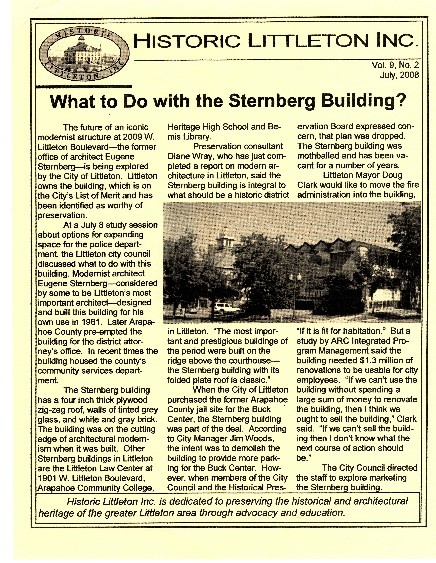


After the 2005 destruction of the Marathon Oil Company research facility, the City of Littleton realized that a significant architectural period of its history could be silently lost. (The Marathon Oil property on the northeast corner of Broadway and Dry Creek Road was a significant representation of the International style with its horizontal lines, grouped windows, lack of ornamentation, and flat roof. Wilbur Watson Associates of Cleveland, Ohio, designed the building. The City applied for a Certified Local Government (CLG) grant in 2006 to fund a survey of post-war buildings, resulting in the 2008 publication of “Historic Context of Littleton Colorado 1949–1967; Live in the Suburbs/Shop in the Suburbs” by Diane Wray Tomasso. (ShowDocument (littletongov.org) This report catalogs the significance of historic buildings to increase community awareness of their importance.
Around the same time, the City-owned Sternberg Building, the former architectural office of Eugene Sternberg, was unoccupied and threatened with demolition. Community concerns intensified about the potential loss and the building was saved. Over the next few years, interest in Mid-Century Modern architecture continued to increase. People born in the mid to late 1950s grew up with the style and could relate to it. They had a direct connection to the architectural period, and they gained more appreciation for the aesthetic and history as the years went by. No additional preservation protection was occurring, however, and a weakening of the Littleton Historic Preservation Code in 2012 did not help.
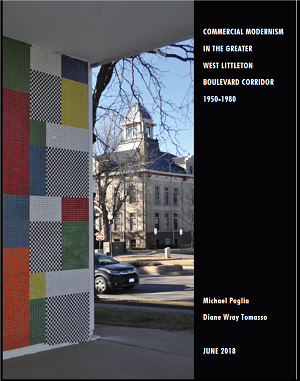
Preservation concerns escalated and ultimately resulted in Littleton Boulevard being placed on Colorado Preservation Inc.’s 2014 Colorado’s Most Endangered Places List. (Mid-Century Buildings of Littleton Blvd. (coloradopreservation.org). This elevated the significance of Littleton’s Mid-Century Commercial architecture, which represents the highest concentration of post–World War II buildings anywhere in Colorado.
The City of Littleton applied for a State Historic Fund grant in 2015, which resulted in the 2018 publication of “Commercial Modernism in the Greater West Littleton Boulevard Corridor 1950–1980.” ShowDocument (littletongov.org). The report showed how broad historical, cultural, economic, and demographic changes after WWII in Littleton were reflected in the architecture.
The Littleton community is finally embracing its Mid-Century Modern heritage. Development and economic growth, however, continue to be the biggest threats to protection of Littleton’s post-war heritage.

